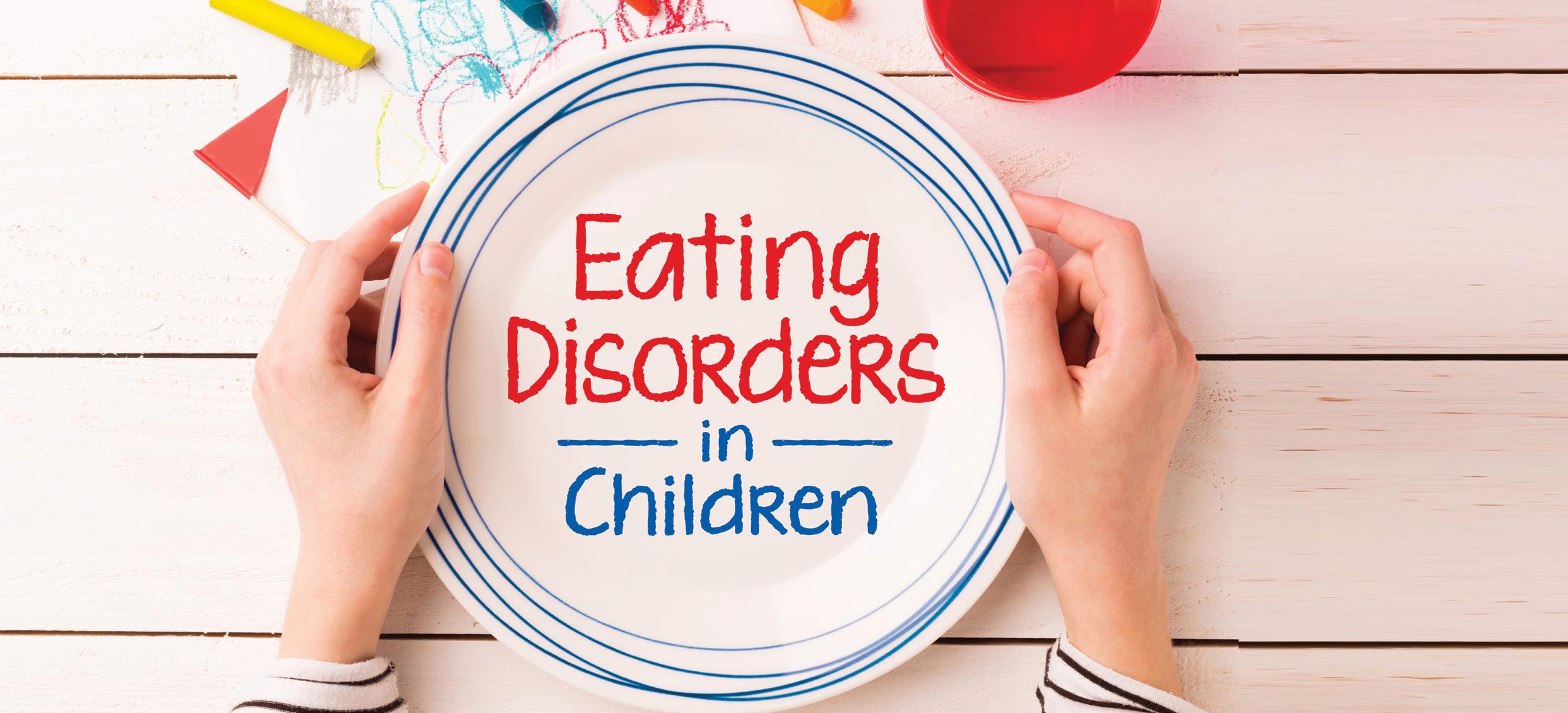
14 minute read
A PROBLEM — ARFID
WHEN PICKY EATING IS A PROBLEM: WHAT PARENTS NEED TO KNOW ABOUT ARFID
By Malia Jacobson Happily, pickiness is a passing childhood phase for most kids. It can even be a healthy sign that children are eating intuitively, according to their own internal cues of hunger or fullness, says Devan Weir, a registered dietitian on staff at THIRA Health, a mental health treatment center for women and girls in Bellevue, Washington.
Advertisement
In some children, though, picky eating is an early sign of Avoidant Restrictive Food Intake Disorder (ARFID), a little-known eating disorder that can cause severe nutritional deficiencies, developmental delays and family chaos. The term is unfamiliar to most parents and healthcare providers, even though ARFID affects between 5 and 14 percent of children and nearly a quarter of those in treatment for eating disorders, according to the Journal of Eating Disorders.
“Most people with eating disorders are not meeting their energy needs (nutrition intake, energy expenditure) due to their behaviors, says Stephenie B. Wallace, MD, MSPH FAA, Associate Professor, UAB Pediatrics Division of Adolescent Medicine. “For patients with Anorexia nervosa and bulimia, their behaviors regarding their energy needs are influenced by their poor body image. Patients with ARFID are not driven by their body image in the changes that occurred in their nutritional habits.”
What is ARFID?
Sometimes characterized as extreme pickiness, ARFID is an eating disorder involving an aversion to food and eating. “This isn't just picky eating,” says Weir. “ARFID is really extreme to the point where it's causing malnutrition and medical consequences.”
“Patients with ARFID have disrupted food intake based on other concerns, such as texture/color, fear of vomiting, or choking but also there are physical consequences of their reduce intake,” Wallace says. “They have poor growth parameters such as significant weight loss, or have nutritional deficiencies. Overcoming this nutritional intake deficits can be a challenge and required frequent evaluations with dietitians and therapists. “The difference between ARFID and picky eating is that the health of children with ARFID is gravely affected by the changes in their nutrition intake” Wallace explains. “Picky eaters continue to grow and develop as expected for their age. A key part of the diagnosis for ARFID is that a nutritional deficiency, significant weight loss or reduced height growth are signs that their health is impacted by their behaviors. Children with ARFID can be affected socially as well as eating in social situations can affect relationship with family and friends.” Formerly called “selective eating disorder,” ARFID is a relatively new diagnosis defined in the 2013 edition of the DSM, the Diagnostic and Statistical Manual of Mental Disorders published by the American Psychiatric Association. Although experts believe that ARFID is on the rise, plenty of healthcare providers haven't heard of the condition, notes Weir. “Up to 63 percent of pediatricians and sub-specialists are unfamiliar with it, so parents often need to search around to find support and help.” Blood tests don't detect ARFID, making the disorder even harder to identify and treat, according to the National Eating Disorder Association (NEDA). The condition occurs in adults but is more common in children, particularly in those on the autism spectrum. Children with ARFID may have an anxiety disorder or sensory processing disorder. Researchers report that youth with ARFID are more likely to be male and have other psychiatric or mental health conditions. The most visible symptoms of ARFID are similar to other eating disorders and include dramatic weight loss, lethargy, cold intolerance, and digestive problems like constipation, cramps, or “upset stomach.” But unlike anorexia nervosa, ARFID isn't characterized by a distorted body image or fear of weight gain, says Mehri Moore, MD, THIRA Health's medical director and founder.
Because children with AFRID often report gastrointestinal discomfort after eating, they may begin to fear foods that might bring on symptoms and be afraid of choking or vomiting. They may have little motivation to eat and claim to be full or suffering from a stomachache when mealtimes roll around. As the disorder progresses, children may whittle down their list of acceptable foods to a single type or texture, protesting if anything else touches their plate. Without treatment, ARFID can persist into adulthood. One study found that more than 17 percent of adult women seeking treatment for gastrointestinal problems met at least some of the diagnostic criteria. ARFID can cause neurological and growth problems in children as the body slows its metabolic process to conserve energy. In extreme cases, nutritional deficiencies can cause fatal electrolyte imbalances or cardiac arrest.
Warning Signs
Stalled growth and "falling off the weight chart" can be red flags for ARFID, especially when accompanied by low energy, difficulty concentrating, fears about food, and disinterest in eating. But caregivers won't always notice dramatic weight loss when their child has ARFID or another eating disorder, notes Moore. In fact, changes in eating-related behavior without any change in weight should peak parental interest, Moore says. “When children and teens show either an increase or decrease in their interest in food, or do things like hide food in their bedroom, and parents don't notice any change in weight, that's a time to become curious.” If picky eating doesn't resolve by grade school, becomes more extreme as children get older and seems to be affecting a child's physical or mental health, an evaluation may be in order, says Weir. “Parents can start with their pediatrician and find additional resources and support from the Ellyn Satter Institute, the National Eating Disorder Association, and THIRA Health, where we specialize in eating disorder recovery.” “If parents are worried, their child should be evaluated by their doctor, Wallace says. “During that assessment, the doctor can take a nutrition history to determine if there are concerns for nutritional deficiencies along with their vital signs. Reviewing the impact of current nutritional intake on their current growth percentiles is key. With prior records, the physicians can determine if their height growth have changed from prior assessments. Children with AFRID can also have other conditions such as autism, OCD and anxiety that are contributing to the behaviors causing their reduced intake.” “Once it has been determined there is an impact on their child’s health, an evaluation from a dietitian and therapist is necessary for recovery, Wallace adds. “The dietician can provide an assessment on what foods need to be added to address growth and development concerns. For patients to increase their oral intake, frequent behavioral therapy sessions will be required. If oral intake is not sufficient and medical parameters are worsening, tube feeding can be used to provide nutrition. There are no specific medications that treat ARFID but medications can be used to better manage their co-occurring conditions.” Parents need support, too. Eating disorders like ARFID are not only developmentally dangerous for children, but extremely challenging for caregivers, says Moore. “Often, we'll see that parents are doing a balancing act, making different meals for different family members while trying to manage extreme food preferences for one child. Because of the strain that an eating disorder places on everyone in the household, it’s important to seek out whole family healing.”
Malia Jacobson is a nationally published health and family journalist. Carol Muse Evans, Birmingham Parent publisher, also contributed to this story.
Children born into all kinds of circumstances have dreams and dreams are powerful.
WE DO WHAT WE DO BECAUSE CHILDREN HAVE DREAMS.
Children’s of Alabama is dedicated to helping kids live the most fulfilling life possible. We put in a lot of time and training to make that happen.

1600 7TH AVENUE SOUTH BIRMINGHAM, AL 35233 (205) 638-9100 ChildrensAL.org
What is Tourette syndrome?
By Carol Muse Evans According to the Tourette Association of America, Tourette syndrome (TS) is a neurodevelopmental disorder characterized by sudden, involuntary movements and/ or sounds called tics. They can include eye blinking, head jerking and facial movements such as throat clearing, sniffing and tongue clicking. “The statistics on TS are that one in 100 school-age children have Tourette syndrome or tic disorders in some form,” according to Dr. Julie Savage Jones, a registered nurse with a doctorate in education who has served as the support group leader for the Tourette syndrome support group of central Alabama since 2013. She has three children with TS. One out of every 100 children ages 5-17 has TS or another Tic disorder, according to the Tourette Association. It is now estimated that one million Americans are impacted, and 50 percent are going undiagnosed. Tourette syndrome affects all races, ethnicities, genders and ages, and it is three to four times more common in boys than girls. “Tics can appear as early as three to four years but the average age is seven years, says Dr. Jan Rowe, OT, OTR/L, FAOTA, coordinator of the Tourette syndrome and Tic disorders Clinic and co-director, COA/UAB Tourette Center of Excellence at Children’s at Lakeshore.
“The worst years (peak) is 10-21 years of age,” Rowe explains. “One third of people’s tics resolve, one third lessen before adulthood and one third will have tics into adulthood.”
According to the Association, Tourette is underdiagnosed. Many children, parents, teachers and even physicians don’t fully understand TS, which can lead to bullying, a lack of community support, an improper diagnosis and a host of other issues that impair the quality of life for someone with TS. It is important to mention there is no cure for Tourette and the cause remains unknown, though it is thought to involve genetic, neurological and environmental factors that may be treated. “TS can manifest in a number of ways, and it is multifaceted. It is not all about the tics,” Jones explains. “There are associated issues that go along with TS, such as Attention Deficit Hyperactivity Disorder, obsessive compulsive disorder, learning disabilities, anxiety and sensory issues.”
“The syndrome manifests in a number of ways,” Jones agrees. “My oldest son struggled in school. He had almost every one of the co-occurring conditions, including sensory issues. Certain sounds bothered him. The feeling of cotton used in art class bothered him. Many types of pencils (the way that they felt) bothered him. He could not sit still even in the fourth grade. He was impulsive. He made noises. All of these behaviors caused problems in school. As a result, I decided to homeschool him, starting in the fourth grade.”
Doctors look for the following to diagnose Tourette syndrome in particular, according to the Association: • At least two motor tics and at least one vocal (phonic) tic have been present, not necessarily at the same time. • Tics may wax and wane in frequency but have occurred for more than one year. • Tics started to appear before the age of 18. • Tics are not caused by the use of a substance or other medical condition. There is no cure for Tourette syndrome, but thanks to years of dedicated research, there are various treatment options. Tourette syndrome is a lifelong condition, according to the Association. Some tic disorders may be transient, but for 66 percent of people, TS persists into adolescence and adulthood. “Tics can cause physical discomfort, disrupt daily activities such as school work, social interactions, sleep and play,” Rowe says. “As children get older, work duties and even driving can be compromised because of tics.”
However, TS can be treated. “Individualized education plans can help children with TS and learning issues, Savage says. Comprehensive Behavioral Intervention for Tics is a therapy that has been found to be as effective as medications without the potential side effects of medication…. Sometimes homeschool is the best educational option. It has been for us, but it is not for everyone,” Jones says. “The gold standard of care for children with tics and TS is Cognitive Behavioral Intervention for Tics (CBIT),” Rowe adds. “This is a non-pharmacological behavioral program. We teach strategies to interrupt tics. This is no cure for tic disorders but CBIT teaches youth to manage their ticks.”

Photo of Tourette Advocacy Day Courtesy of Tourette Association of America
On March 3, advocates from The Tourette Association of America will virtually advocate for the most pressing issues facing the Tourette community on National Advocacy Day. The Pre-Advocacy Day Evening Kick-off will include guest speaker Ben Brown, host of Tourette's Podcast (https://www.tourettespodcast.com/), Jerry Gidner, Director of the Bureau of Trust Funds Administration at the U.S. Department of the Interior, and Congressional staff. More information at https://tourette.org/public-policy/take-action-on-tourette-national-advocacy-day/.
Continued from page 12 conveying that you hear him goes a long way in allaying concerns. Open and honest dialogue helps build a trusting,open relationship that will be a solid foundation as other fears and feelings come up.
Fix your focus on the positive.

With so much negative news, making your home a positive place helps your children regard home as their haven. Being positive doesn’t mean sugarcoating things, but rather purposefully finding the positive things, big or small. Children take your lead when it comes to their outlook, so your good attitude goes a long way to create an overall positive atmosphere. Establish your home as their safe escape when the world feels cold.
Create rhythm and routine.
When school is virtual, work is from home, and activities are cancelled indefinitely, it can be tempting to toss routine. The truth is both you and your kids need routine more than ever. The predictability of a daily schedule helps soothe anxiety caused by the world’s unpredictability. Though routine may look differently than in pre-pandemic times, you can still infuse your days with structure. Follow a general daily order to give the guardrails we all crave, and let them weigh in on the routine for an added sense of ownership.
Put on your own oxygen mask.
Self-care has become a buzzword, but despite the trendiness, the concept is crucial. You’re only able to help others when you function at your best. By taking measures to create margin, you increase your ability to respond to your children with patience and grace. Ask yourself what activities make you feel more like you. Carve out time for those activities and remove unnecessary draining activities. Practicing self-care gives you the fuel you need so you can pour into others, and also models an invaluable life skill for your kids.
Make discipline positive.
When circumstances feel out of control, our natural inclination can be to overexert control anywhere we can. The problem is hypercontrolling our kids can lead to more harm than good. While you may get momentary compliance, the results are short-term at best, and may result in long term relational damage and an underdeveloped sense of personal responsibility in your child. The added together time brought by the pandemic makes it a perfect time to work with your kids to brainstorm solutions to discipline problems without relying on control, nagging, and punishment. Creating positive discipline patterns, rather than punishment-based models, will transform your relationship and offer more effective results.
Create a Sense of Accomplishment.
Who among us doesn’t need some wins? For the same reasons you enjoy little victories, your kids also crave accomplishment. With some of the usual kid-centric wins of classroom achievements, sports victories, and extracurricular efforts currently on hold, experiencing wins at home becomes even more crucial. Give your child responsibilities that she can check off each day. It doesn’t have to be big or glamorous to create a sense of satisfaction. Help your kids set goals they can work towards with small daily steps. Try making a chart to record progress or highlight everyone’s victories at dinner each night. The feeling of accomplishment builds a lasting sense of self-esteem and personal responsibility.
Seek Support.
Sharing a burden is the best way to reduce its weight so talk candidly about struggles with friends. Simply knowing you aren’t alone in your struggles gives a boost. In addition to talking with friends, seeking out the help of a professional counselor or coach is one of the most valuable things you do for yourself as a parent. In stressful times, having a professional on your team equips you with an invaluable tool set. Furthermore, studies have shown children of anxious parents are more likely to suffer from anxiety themselves, according to the National Center for Biotechnology Information, so by working on your own mental health, you can help reduce your child’s likelihood of suffering from anxiety.
Let Grace Abound for All.
If there was ever a time to dole out grace recklessly, it’s certainly now. We are all dealing with shorter fuses. Just as stress levels can cause your own behavior to be less than ideal, stress can also cause your children to act out. Keep this in mind as you deal with your children and yourself. We will make mistakes on a daily basis during a pandemic, and during ordinary times. Apologize freely, give and receive grace, and fix your eyes on moving forward. Mistakes will happen. Homes where grace abounds give a safe place to get back up after those inevitable falls.
Tyler Drouet, MA, Ed.S. is a parenting coach with Simplify Atlanta where she works with parents of children from birth through high school. Contact her at tyler@simplifyatlanta.











